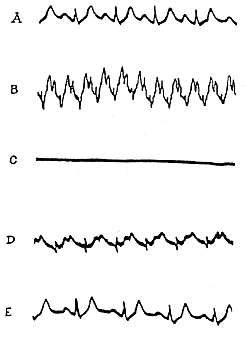
The yogic claim of voluntary control over the heart beat:
A letter to the American Heart Journal - 1973
LK Kothari MSc MAMS, Arum Bordia MD, VP Gupta MD
Rabindinath Tagore Medical Colledge & Hospital; Udapur India
Yogis in India have long been reputed to develop a remarkable control over bodily functions. Theoretically, it is believed that all visceral functions can be brought under voluntary control by prolonged yogic training, but perhaps their most fascinating claim has been the ability to stop the heart at will. However, in most instances where this has been investigated so far, it has turned out to be an exaggerated Valsalva manoeuvre in some form, which makes the pulse and heart sounds imperceptible while the heart continues to beat at a slow rate.
Recently we had the rare opportunity of investigation of an altogether different and very interesting demonstration of this supposed yogic control over the heart. Yogi Satyamurti, a sparsely built man of about 60 years of age, remained confined in a small underground pit for 8 days in what according to him was a state of "Samadhi", or deep meditation, with all bodily activity cut down to the barest minimum. The pit was a 1.5 metre cube, dug out in an open lawn surrounded by the Medical Institute buildings, and was completely sealed from the top by bricks and cement mortar. The Yogi squatted on the floor of the pit with nothing on excepted a light cotton garment. About 5 litres of water was placed in the corner, presumably for drinking but according to the Yogi only for keeping the air humid. An ECG (Lead II) was continuously monitored during these 8 days and various other laboratory investigations were carried out before and after. The ECG leads were kept short enough not to allow any free movement inside the pit.
The 12-lead ECG recorded before closing the pit was within normal limits (Fig. 1, strip A), but a significant sinus tachycardia developed soon after. It increased progressively, reaching a heart rate of 250 per minute on the second day (Fig.1,strip B). At 5:15 pm on the second day, when the yogi had been inside for about 29 hours, to our great surprise a straight line replaced the ECG tracing (Fig.1, strip C). There was no electrical disturbance of any sort even at higher amplification and with different leads. There had been no slowing of the heart or signs of ischaemia preceding this.

The straight line on the ECG persisted till the eighth morning. Then, to our astonishment, electrical activity returned about half an hour before the pit was scheduled to be opened. After some initial disturbance, a normal configuration appeared. Although some sinus tachycardia was still there, there was no other significant abnormality (Fig.1, strip D). The Yogi had informed us beforehand that he would begin to come out of his deep trance or suspended animation after nearly 7 days, much in the same way that a normal person wakes up after a few hours sleep.
When the pit was opened on the eighth day, the Yogi was found sitting in the same posture. One of us immediately went to examine him. He was in a stuporous condition and was very cold (oral temperaturewas 34.8°C). On being taken out of the pit he developed severe shivering and this persisted for nearly 2 hours. A 12-lead ECG repeated in the laboratory subsequently was again within normal limits (Fig.1, strip E).
The Yogi and his admirers felt more satisfied at his scientifically documented proof of a remarkable Yogic feat, while we were left rather perplexed and confused. We were expecting some bradycardia and possible sign of myocardia ischaemia, but contrary to this there was severe tachycardia followed by a complete disappearance of all complexes. Any instrumental failure was ruled out by thoroughly checking the machine and also by the spontaneous reappearance of the ECG on the last day. A disconnection of the leads by the Yogi, quite a likely explanation, ought to have given rise to a considerable electrical disturbance, but there was hardly any. Later on, we tried all sorts of manipulations with leads to stimulate what the Yogi could have done inside the pit (notwithstanding the total darkness and his ignorance of ECG technique), but in every case there was marked disturbance. Therefore, although it is obviously difficult to believe that the Yogi could have completely stopped his heart or decreased its electrical activity below a recordable level, we still had no satisfactory explanation for the ECG tracings before us.
Apart from this, the Yogi had of course endured total starvation, sensory deprivation, as well as the discomfort of a very humid, closed atmosphere for 8 days. We did not pay much attention to anoxia, thinking that sufficient ventilation could occur through the bare earth on the side of the pit. The loss of weight (4.5 kilograms) and other biochemical changes were essentially the same as can be expected in starvation under similar conditions. They certainly discount any remarkable depression of the metabolic rate.
The more optimistic amongst us considered this feat to be a marvellous extension of the "hypometabolic wakeful state of yogic meditation" as described by Wallace and co-workers, and the conditioned learning of autonomic responses in rats reported by DiCara. The sceptics, however, were inclined to take the whole thing as some cleverly disguised trick. But, for the present, we only want to put this interesting experiment on record just as an intriguing and inclusive attempt of a Yogi to demonstrate a voluntary control over his heart beat.
©Copyright Knowledge of Reality Magazine 1996-2006. All rights reserved.
Any comments, queries please email us.